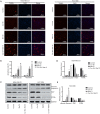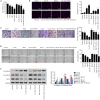Curcumol enhances the anti-tumor effects of metformin via suppressing epithelial-mesenchymal transition in triple-negative breast cancer
- PMID: 32953746
- PMCID: PMC7475397
- DOI: 10.21037/atm-20-5438
Curcumol enhances the anti-tumor effects of metformin via suppressing epithelial-mesenchymal transition in triple-negative breast cancer
Abstract
Background: Triple-negative breast cancer (TNBC) is a severe disease with a high mortality rate. Metformin has been found to possess anti-tumor properties. Curcumol, an active ingredient extracted from curcuma, exerts the protective effect in TNBC cells through inducing apoptosis. However, the effects of curcumol combined with metformin on the treatment of TNBC have yet to be fully established.
Methods: TNBC cells MDA-MB-231 and MDA-MB-468 cells were used in the study. TNBC cells were treated with curcumol and metformin alone or treated with curcumol combined with metformin. Cell viability was determined using Cell Counting Kit-8 (CCK-8) assay. Cell apoptosis was detected using terminal deoxynucleotidyl transferase dUTP nick end labeling (TUNEL) assay. The levels of proteins were measured using Western blot. Wound healing assay and Transwell invasion assays were used to determine cell migration and invasion ability, respectively. A xenograft model was established to investigate the tumor growth ability. Immunohistochemistry was performed to determine the expression of Ki-67 and Vascular endothelial growth factor (VEGF).
Results: In the study, the administration of curcumol alone had no significant effects on the TNBC cells. However, the anti-proliferation, anti-metastasis, and anti-epithelial-mesenchymal transition (EMT) effects of metformin were enhanced by the addition of curcumol. Further, curcumol reversed TNBC cell proliferation, migration, invasion, and EMT induced by rucaparib, and enhanced the effect of metformin on rucaparib-induced TNBC cells. The combination of curcumol and metformin also suppressed tumor growth, EMT marker expression, and the activation of Wnt2/β-Catenin signaling during in vivo experiments.
Conclusions: The combination of curcumol and metformin enhances the anti-tumor effects of metformin on TNBC via inhibiting EMT. Curcumol combined with metformin may hold promise as a therapeutic strategy for TNBC.
Keywords: Triple-negative breast cancer (TNBC); curcumol; epithelial–mesenchymal transition; metformin.
2020 Annals of Translational Medicine. All rights reserved.
Conflict of interest statement
Conflicts of Interest: All authors have completed the ICMJE uniform disclosure form (available at http://dx.doi.org/10.21037/atm-20-5438). The authors have no conflicts of interest to declare.
Figures





Similar articles
-
MicroRNA-543 inhibits the proliferation, migration, invasion, and epithelial-mesenchymal transition of triple-negative breast cancer cells via down-regulation of ACTL6A gene.Clin Transl Oncol. 2022 Jan;24(1):84-92. doi: 10.1007/s12094-021-02672-z. Epub 2021 Jun 28. Clin Transl Oncol. 2022. PMID: 34181232
-
Curcumol enhances the sensitivity of doxorubicin in triple-negative breast cancer via regulating the miR-181b-2-3p-ABCC3 axis.Biochem Pharmacol. 2020 Apr;174:113795. doi: 10.1016/j.bcp.2020.113795. Epub 2020 Jan 10. Biochem Pharmacol. 2020. PMID: 31926937
-
Curcumol triggers apoptosis of p53 mutant triple-negative human breast cancer MDA-MB 231 cells via activation of p73 and PUMA.Oncol Lett. 2017 Jul;14(1):1080-1088. doi: 10.3892/ol.2017.6273. Epub 2017 May 29. Oncol Lett. 2017. PMID: 28693277 Free PMC article.
-
Anti-TNBC effects of Lappaol F by targeting epithelial-mesenchymal transition via regulation of GSK-3β/YAP/β-catenin and PI3K/AKT pathways.Front Pharmacol. 2025 Feb 7;16:1496511. doi: 10.3389/fphar.2025.1496511. eCollection 2025. Front Pharmacol. 2025. PMID: 39989901 Free PMC article.
-
Metformin-Based Combination Approaches for Triple-Negative Breast Cancer.Pharmaceutics. 2025 Apr 24;17(5):558. doi: 10.3390/pharmaceutics17050558. Pharmaceutics. 2025. PMID: 40430851 Free PMC article. Review.
Cited by
-
Curcumol repressed cell proliferation and angiogenesis via SP1/mir-125b-5p/VEGFA axis in non-small cell lung cancer.Front Pharmacol. 2022 Nov 18;13:1044115. doi: 10.3389/fphar.2022.1044115. eCollection 2022. Front Pharmacol. 2022. PMID: 36467048 Free PMC article.
-
Ruyiping formula inhibits metastasis via the microRNA-134-SLUG axis in breast cancer.BMC Complement Med Ther. 2021 Jul 5;21(1):191. doi: 10.1186/s12906-021-03365-4. BMC Complement Med Ther. 2021. PMID: 34225726 Free PMC article.
-
The function, mechanisms, and clinical applications of metformin: potential drug, unlimited potentials.Arch Pharm Res. 2023 May;46(5):389-407. doi: 10.1007/s12272-023-01445-2. Epub 2023 Mar 24. Arch Pharm Res. 2023. PMID: 36964307 Review.
-
Curcumol inhibits the malignant progression of prostate cancer and regulates the PDK1/AKT/mTOR pathway by targeting miR‑9.Oncol Rep. 2021 Nov;46(5):246. doi: 10.3892/or.2021.8197. Epub 2021 Sep 30. Oncol Rep. 2021. PMID: 34590156 Free PMC article.
-
Dapagliflozin alleviates cardiac fibrosis through suppressing EndMT and fibroblast activation via AMPKα/TGF-β/Smad signalling in type 2 diabetic rats.J Cell Mol Med. 2021 Aug;25(16):7642-7659. doi: 10.1111/jcmm.16601. Epub 2021 Jun 25. J Cell Mol Med. 2021. PMID: 34169635 Free PMC article.
References
LinkOut - more resources
Full Text Sources
Miscellaneous
